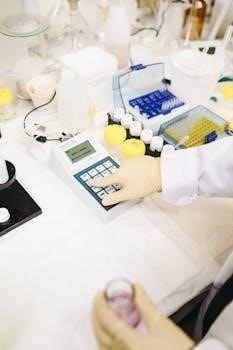Mosby’s Manual serves as an indispensable resource for healthcare professionals․ It simplifies understanding‚ performing tests‚ and interpreting results․ This manual offers concise coverage of commonly performed diagnostic and laboratory tests‚ proving valuable in both academic and practical settings․
Purpose and Importance of Diagnostic Tests
Diagnostic tests play a crucial role in modern healthcare‚ serving as essential tools for accurate and timely medical decisions․ These tests are performed to identify diseases‚ monitor their progression‚ and evaluate the effectiveness of treatment plans․ The primary purpose of diagnostic tests is to provide objective information about a patient’s health status‚ enabling healthcare professionals to make informed diagnoses and treatment recommendations․
The importance of diagnostic tests lies in their ability to detect abnormalities or deviations from normal physiological functions․ By analyzing various biological samples‚ such as blood‚ urine‚ or tissue‚ these tests can reveal the presence of infections‚ genetic disorders‚ or other underlying health conditions․ Early detection of diseases through diagnostic testing can significantly improve patient outcomes‚ as it allows for prompt intervention and management․
Moreover‚ diagnostic tests are vital for monitoring the effectiveness of treatments and adjusting them as needed․ Regular testing helps healthcare providers assess whether a particular therapy is working as intended‚ and make necessary modifications to optimize patient care․
Role of Laboratory Tests in Diagnosis
Laboratory tests are integral to the diagnostic process‚ providing objective and quantifiable data that complements clinical assessments․ These tests analyze biological specimens‚ such as blood‚ urine‚ and tissue samples‚ to identify abnormalities or markers indicative of disease․ The results obtained from laboratory tests offer valuable insights into a patient’s physiological state‚ aiding in the confirmation or exclusion of specific diagnoses․
The role of laboratory tests in diagnosis extends beyond simply detecting the presence of disease․ They also help determine the severity of the condition‚ monitor its progression‚ and assess the effectiveness of treatment interventions․ By tracking changes in laboratory values over time‚ healthcare professionals can gain a comprehensive understanding of the patient’s health status and make informed decisions regarding their care․
Moreover‚ laboratory tests play a crucial role in preventive medicine․ Routine screenings‚ such as cholesterol and blood sugar tests‚ can identify individuals at risk for developing certain conditions‚ allowing for early intervention and lifestyle modifications to mitigate potential health problems․ The accuracy and reliability of laboratory tests are paramount to ensure accurate diagnoses and appropriate patient management․

Common Diagnostic Tests
Diagnostic tests‚ detailed in Mosby’s Manual‚ encompass a wide range of procedures․ They aid in identifying diseases and monitoring patient health․ These tests are vital tools for medical professionals․
Overview of Frequently Performed Tests
Mosby’s Manual of Diagnostic and Laboratory Tests provides an overview of over 700 frequently performed tests‚ offering clear and concise information․ This comprehensive resource is valuable for healthcare professionals in both academic and clinical settings․ The manual covers a wide range of diagnostic and laboratory tests‚ ensuring that users have access to essential information for accurate diagnosis and patient care․
The manual’s focus on frequently performed tests makes it a practical tool for everyday use․ It helps healthcare providers quickly access the information they need to understand and perform tests correctly․ The clear and concise format of the manual ensures that users can easily find the information they need‚ even in a fast-paced clinical environment․ Moreover‚ it aids in result interpretation and patient teaching․
This overview equips professionals with the knowledge to confidently navigate common diagnostic procedures‚ fostering improved patient outcomes․ Selected for Doody’s Core Titles in Laboratory Technology‚ it highlights the manual’s importance․
Application of Rapid Influenza Diagnostic Tests (RIDTs)
Rapid Influenza Diagnostic Tests (RIDTs) find their most useful application outside traditional laboratory settings‚ playing a crucial role in the diagnostic algorithm for influenza․ While many RIDTs are licensed for use outside of a laboratory‚ their accessibility makes them valuable tools in various clinical environments․ These tests offer quick results‚ aiding in timely diagnosis and treatment decisions during influenza season․
The primary advantage of RIDTs lies in their ability to provide rapid results‚ typically within minutes․ This allows healthcare professionals to quickly identify influenza infections and initiate appropriate treatment strategies․ However‚ it’s important to note that RIDTs may have varying levels of sensitivity and specificity compared to more complex laboratory tests․ Therefore‚ results should be interpreted carefully‚ considering clinical context and potential for false negatives or positives․
RIDTs contribute significantly to managing influenza outbreaks‚ especially in point-of-care settings․ They enable prompt identification and isolation of infected individuals‚ limiting spread․

Interpreting Laboratory Results
Understanding lab results is crucial․ Mosby’s Manual aids in interpreting lab results․ This assists in accurate diagnoses‚ understanding reference ranges‚ and recognizing factors that influence test outcomes for effective patient care․
Understanding Reference Ranges
Reference ranges‚ also known as normal values‚ are crucial in interpreting laboratory results; These ranges represent the expected values for a particular test in a healthy population․ Understanding these ranges is essential for clinicians to determine if a patient’s test result falls within the normal limits or indicates a potential health issue․
Mosby’s Manual of Diagnostic and Laboratory Tests provides comprehensive information on reference ranges for a wide variety of tests․ It’s important to note that reference ranges may vary slightly depending on the laboratory and the specific method used for testing․ Therefore‚ it’s always best to refer to the reference ranges provided by the laboratory that performed the test․
Factors such as age‚ sex‚ and ethnicity can also influence reference ranges․ Understanding these nuances is critical for accurate interpretation of laboratory results and appropriate patient management․ Always consider the patient’s individual characteristics when evaluating test results․
Factors Influencing Test Results
Accurate interpretation of laboratory tests requires an understanding of various factors that can influence the results․ Patient-specific factors‚ such as age‚ sex‚ race‚ diet‚ and medication use‚ can significantly impact test outcomes․ For instance‚ certain medications can elevate liver enzyme levels‚ while dietary changes may affect cholesterol levels․
Sample collection and handling techniques are also crucial․ Improper collection‚ storage‚ or transportation of samples can lead to inaccurate results․ The timing of the test‚ such as fasting versus non-fasting‚ can also influence glucose and lipid levels․ Furthermore‚ physiological factors like stress‚ exercise‚ and pregnancy can alter hormone levels and other analytes․
It’s essential to consider these factors when interpreting laboratory results to avoid misdiagnosis or inappropriate treatment․ Mosby’s Manual of Diagnostic and Laboratory Tests provides detailed information on these influencing factors for various tests‚ aiding in accurate clinical decision-making․

Mosby’s Manual of Diagnostic and Laboratory Tests
Mosby’s Manual is a one-stop resource․ It provides clear‚ concise coverage of diagnostic and laboratory tests․ This valuable manual aids in understanding‚ performing tests‚ and interpreting results effectively․
Overview of Mosby’s Manual
Mosby’s Manual of Diagnostic and Laboratory Tests stands as a quick reference‚ offering clear and concise coverage of over 700 commonly performed tests․ This comprehensive resource simplifies the complexities of diagnostic procedures and laboratory analysis‚ making it an invaluable tool for healthcare professionals in various settings․
The manual is designed to facilitate understanding‚ performance‚ and interpretation of test results‚ essential for accurate patient care․ Selected for Doody’s Core Titles in Laboratory Technology‚ it highlights the manual’s significance in the field․ Its one-stop nature ensures consistent coverage across a wide range of diagnostic and laboratory evaluations․
Whether in academic environments or clinical practice‚ Mosby’s Manual serves as a trusted guide․ It assists in writing care plans‚ understanding testing methodologies‚ and ultimately‚ improving patient outcomes through informed decision-making based on reliable test information․ This edition is available in multiple formats including Vitalsource Interactive eBook and Paperback Book․
Key Features and Benefits of the Manual
Mosby’s Manual of Diagnostic and Laboratory Tests offers numerous key features and benefits that make it an indispensable resource for healthcare professionals․ Its clear and concise coverage of over 700 commonly performed tests ensures quick access to essential information․
The manual simplifies complex procedures‚ aiding in the understanding‚ performance‚ and interpretation of test results; Valuable in academic and clinical settings‚ it supports the development of effective care plans and informed decision-making․ The consistent presentation of information across all tests ensures ease of use and efficient reference․
Selected as a Doody’s Core Title‚ the manual’s reliability is further enhanced by its availability in various formats‚ including interactive eBooks and paperback․ New updates keep practitioners abreast of the latest advancements in diagnostic testing․ Mosby’s Manual is an essential tool for improving patient outcomes through accurate and reliable information․

Performing Diagnostic and Laboratory Tests
Performing tests accurately and understanding results is crucial; Mosby’s Manual aids in this‚ simplifying procedures․ It also supports effective patient teaching and informed decision-making within healthcare settings for improved outcomes․
Essential Steps and Considerations
Performing diagnostic and laboratory tests effectively requires adherence to essential steps outlined in resources like Mosby’s Manual․ Accuracy begins with meticulous preparation‚ including verifying patient identity and correctly labeling specimens․ Understanding the test’s purpose is paramount‚ guiding proper technique and interpretation․
Consideration of patient-specific factors‚ such as medications and medical history‚ is vital․ The manual emphasizes the importance of following standardized procedures to minimize errors․ Maintaining a sterile environment is also crucial to prevent contamination and ensure reliable results․ Quality control measures should be diligently implemented throughout the testing process․
Appropriate handling and storage of specimens‚ as detailed in the manual‚ are essential for preserving integrity․ Documentation must be thorough and accurate‚ recording all steps taken and observations made․ Finally‚ the manual stresses the need for continuous education and training to stay updated on best practices in diagnostic and laboratory testing․

